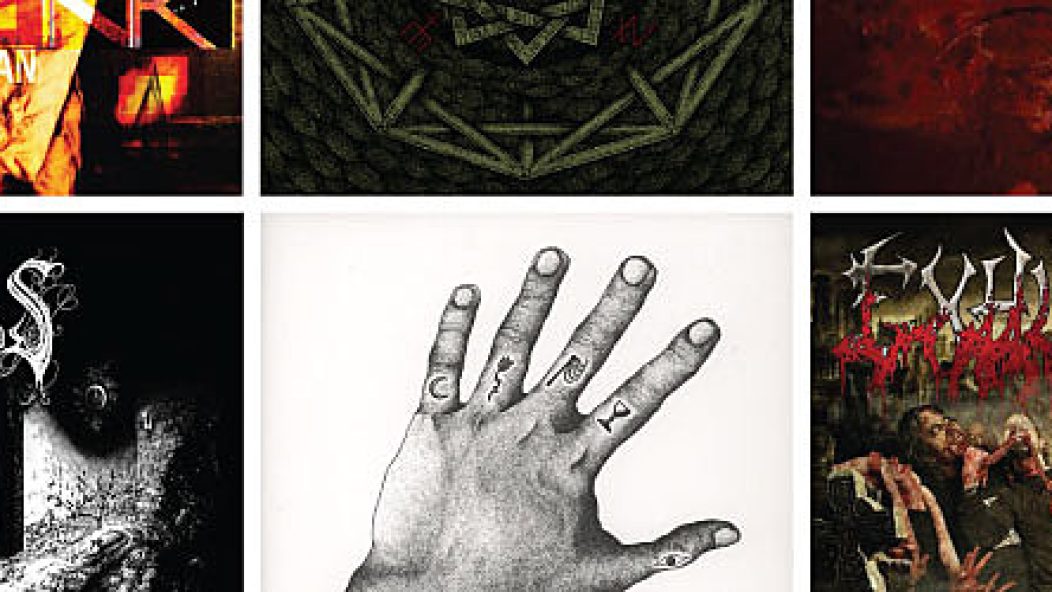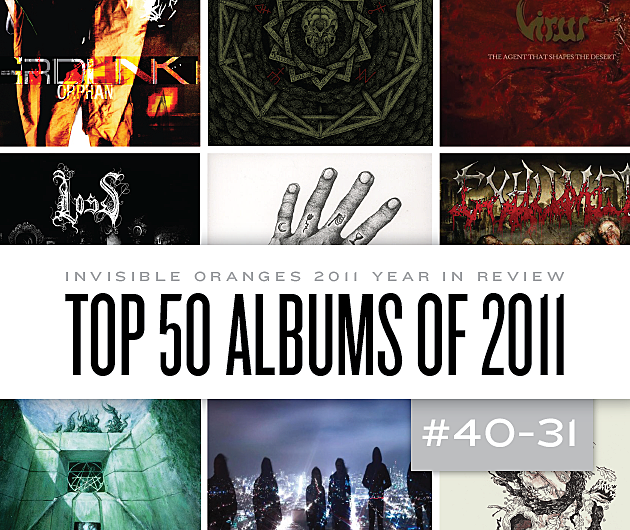
Top 50 Metal Albums of 2011, 40 to 31

For an explanation of how we determined our Top 50 albums of 2011 (and for a look at albums 75 to 51), see our first post in the series, Top Albums of 2011, 75 to 51.
40. Deafheaven – Roads to Judah (Deathwish, USA)
“But, it’s not true black metal!” cry the traditionalists. “Who cares? It’s beautiful,” counter the believers. Thus, having birthed the largest cluster of “blackgaze” acts yet, 2011 saw the melée between the both ends of the underground reach Homeric proportions, with Deafheaven the band that launched a thousand ships. Roads to Judah vindicated both sides – its blown-out and sped-up hardcore riffing and distant howling has more in common with Envy than Emperor, actually warranting the use of the often mis-assigned screamo tag, while its constant snare and cymbal punishment kept one foot in the kvlt for most of its runtime. The San Francisco duo-turned-quintet didn’t set out to write the sequel to De Mysteriis Dom Sathanas, but we couldn’t be happier. —Greg Majewski
. . .
Deafheaven – “Language Games”
. . .
39. Exhumed – All Guts No Glory (Relapse, USA)
A good album should be like a good meal: both enjoyable to the senses during its intake, and wholly satisfying upon completion. Such a blood-soaked flesh-feast is All Guts No Glory, the first album in six years by California-based gore metal innovators Exhumed. Clocking in at a concise 36-odd minutes, Guts is an unstoppable blast of old-school death metal, with heaping helpings of ominous breakdowns, neck-snapping leads, and power-punch choruses that keep the listener grinning from start to finish. And while the lyrics revel in gore – the last song has the amazing title “So Let It Be Rotten… So Let It Be Done” – the music branches out from typical goregrind with bursts of groove and atmosphere. Non-believers beware—the saw is alive. —Scab Casserole
. . .
http://www.youtube.com/watch?v=KfFi_5AK8lQ
Exhumed – “Through Cadaver Eyes”
. . .
Read the Invisible Oranges interview with Exhumed.
38. Circle of Ouroborus – Eleven Fingers (Handmade Birds Records, Finland)
Circle of Ouroborus’s Eleven Fingers found the Finnish group expanding on the ethereal sound of 2010’s Unituli, resulting in their most refined album to date. Instrumentalist Atvar highlights the more subdued and melancholy aspects of black metal with atmospheric keyboards and meandering guitar melodies; vocalist Antti Klemi’s delay-drenched lamentations and raw howls complement the ghostly dirges with a sense of longing and uncertainty. Tracks like “Warpath” display their more developed songwriting, with catchier hooks and post-punk drumming, but droning tracks like “Staining the Paper to Create” don’t stray far from the duo’s experimental nature. Eleven Fingers is essential listening for adventurous headbangers, as it reveals the hidden beauty of lo-fi black metal often obscured by tape hiss. —Tom Brandow
. . .
Circle of Ouroborus – “Warpath”
. . .
37. Absu – Abzu (Candlelight Records, USA)
Black metal is getting more popular. It’s also growing ever more serious. That’s why we need bands like Absu. Abzu is the second record in the band’s ongoing trilogy of self-titled records. It falls between Absu and the upcoming Apsu. Theirs is a silly naming convention, and in many ways, Abzu is a silly record: drummer/vocalist “Proscriptor” McGovern kicks things off with a wry Tom Araya shriek. But there’s nothing silly about his blasts, or about Matt “Vis Crom” Moore’s flensing guitar work. Even in 2011, you can still build an awesome album on three-minute black/thrash rippers. Abzu is proof in plastic. —Doug Moore
. . .
Absu – “A Song for Ea”
. . .
36. Loss – Despond (Profound Lore, USA)
In many ways, 2011 was not a great year for Loss. The Nashville band were forced to cancel numerous tour dates due to a recurring injury to guitarist/vocalist Mike Meacham; they had to pull out of an appearance at the Rites of Darkness festival due to “the promoter’s failure to follow through on his promises and obligations”. That’s too bad, because it prohibited the band from effectively promoting a masterpiece. Deliberate and precise, lingering on almost every note and syllable, Despond revels in grief – its song titles read like an especially melodramatic suicide note. But Loss draw out the delicate beauty of emotional agony with intricate, intertwined guitars and climactic instrumental melodies. Despond is as slow and heavy as a battleship, as enveloping and magical as a thick fog. —Mike Nelson
. . .
Loss – “Open Veins to a Curtain Closed”
. . .
35. Mitochondrion – Parasignosis (Profound Lore, Canada)
In contrast to its recent djent-riff-ication, death metal was once an unsettling sonic mass of bands willing to push boundaries while always keeping the principles of songwriting in mind. Thanks to bands like Mitochondrion, and albums like Parasignosis, death metal’s reclaiming its chutzpah, one non-Euclidean riffscape at a time. The shady Canadian trio’s second album resonated with old souls and next-genners alike, with its back-asswards guitar exploitation and throbbing percussion as organic as the band’s cellular name. Drummer Karl Godard earns top honors throughout, but specifically on “Banishment”, where his lurching death march mutates into a half-time groove so catchy, it’ll make Pete Sandoval think twice before sticking around for the “J” album. It’s been out for almost a year and yet Parasignosis remains an unpredictable and harrowing journey. —Greg Majewski
. . .
http://www.youtube.com/watch?v=Li_22ay3uQg
Mitochondrion – “Plague Evockation”
. . .
Read the Invisible Oranges review of Mitochondrion’s Parasignosis.
34. Mastodon – The Hunter (Reprise Records, USA)
While Mastodon progress stylistically with each album, The Hunter captured the Atlanta rockers at a major crossroads. After running the gamut of metal styles, Mastodon have taken their stoner heaviness (Remission), frantic riffing (Blood Mountain), and prog tendencies (Crack the Skye) and synthesized them into their most accessible record yet. The “four classical elements” concept album cycle is finished, and gone are the eight-minute songs and Paul Romano artwork. But it’s still the Mastodon we know and love, with impeccable lead guitar work, dexterous drumming, and strong, collaborative songwriting. The Hunter is not only a great addition to Mastodon’s catalogue: it also represents a step forward in their journey towards becoming America’s next great heavy metal band. —Tom Brandow
. . .
http://www.youtube.com/watch?v=LPp-9Nap2Bs
Mastodon – “Spectrelight”
. . .
33. Hammers of Misfortune – 17th Street (Metal Blade Records, USA)
Often, metal bands incorporating disparate influences into their sound must make sacrifices, trading instrumental mastery for a “retro” or “underground” sound. But on 17th Street, this Bay Area sextet juggles significant handfuls of classic hard rock, modern prog, and pagan folk metal with ease, creating a strange and enthralling record that’s both technically accomplished and charmingly human. On heartbreaking anthems like “The Grain” and “The Day the City Died”, guitarist and band mastermind John Cobbett (also of bleak black metallers Ludicra) chugs and bounces along with infectious vigor, while new vocalist Joe Hutton belts and croons alternately, his soaring power-metal vocals both standing strong on their own, and blending effortlessly with the parts encompassing them. —Scab Casserole
. . .
Hammers of Misfortune – “The Grain”
. . .
Read the Invisible Oranges retrospective of Hammers of Misfortune.
32. Virus – The Agent that Shapes the Desert (Duplicate Records)
Virus is an odd addition to a best-of metal list, because they’re not really metal, other than by virtue of leader Carl-Michael Eide’s association with Ved Buens Ende and Ulver, among others. Their sound rests between a darker King Crimson, and the bizarre funk of SST bands like Saccharine Trust and The Minutemen. Eide speaks his vocals more than sings them, and at times sounds like a cross between Ian Curtis and Peter Murphy, while bassist Petter Berntsen grooves and slides around the fusion flares of drummer Einar Sjursø. But the Virus sound comes from Eide, who provides dark angular guitar riffs that are beautiful in their dissonance, and unpredictable in their resolution. It’s truly a unique sound that has no better home than amongst metal fans. —Aaron Maltz
. . .
http://www.youtube.com/watch?v=QK6gz4FMgoo&feature=results_video&playnext=1&list=PL363780F4803DA25B
Virus – “Chromium Sun”
. . .
31. Gridlink – Orphan (Hydra Head)
When Gridlink shrieker Jon Chang warned fans that the sequel to 2008’s Amber Gray would take a while, given the members’ locations spread across the globe, we should have known he was on Grind Time. Considering Orphan’s 12-song whirlwind of fast guitars and even faster drums condenses down to 12 minutes, the three-year layover is damn near superhuman. All-star skinsman Bryan Fajardo’s “click-click, click-click” stick count at the beginning of each track is the instrumental equivalent of loading two double barrel shotguns of stupefying complexity and delirious speed, while guitarists Takafumi Matsubara and newcomer Steve Procopio’s conjoined six-string buckshot blow both eardrums and minds with intertwining leads and subtle melody beneath the supersonic bedlam. —Greg Majewski
. . .
Gridlink – “Scopedog”
. . .
Read the Invisible Oranges review of Gridlink’s Orphan.











